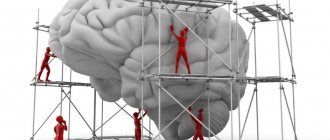Formation and development of science
Stages of development of psychogenetics as a science:
- Stage 1 – the emergence of the genetics of human behavior occurs (1865-1900);
- Stage 2 – behavioral genetics becomes an independent scientific discipline (1900-1924);
- Stage 3 – empirical material is accumulated (1924-1960);
- Stage 4 – modern development (from 1960 to the present).
Psychogenetics as a science was developed by the English scientist F. Galton. He was Charles Darwin's cousin.
In 1865, Galton published the article “Hereditary Talent and Character,” which marked the beginning of a series of works in the field of studying heredity in humans. In 1869, Galton's work “Hereditary Genius: A Study of Its Laws and Consequences” was published. As part of the study, the scientist tried to solve the issue of heritability of talent by analyzing the pedigrees of outstanding figures in science, law, sports, military affairs, and art. To do this, he used the genealogical method.
Are you an expert in this subject area? We invite you to become the author of the Directory Working Conditions
Another founder of psychogenetics is the German researcher W. Stern, who first introduced the concept of “differential psychology.”
Definition 2
Differential psychology is a branch of psychology that studies individual differences between people.
Stern formulated methodological and experimental approaches, basic concepts, and statistical techniques. All of them are still used in psychogenetics.
The main achievements of psychogenetics at the beginning of the 20th century can be considered:
- Formation of reliable methods for determining the zygosity of twins.
- Development of statistical methods for determining similarities between relatives.
- The emergence and development of quantitative genetics.
- Development of testology (psychological diagnostics).
Genealogical method
The genealogical method is a method of compiling a pedigree - a method of collecting and analyzing family trees.
The purpose of the method is to: -Determine the heritability of a trait; Determine the type of inheritance of the trait (autosomal, sex-linked, dominant, recessive); -Identify people, carriers; -Determine the prognosis of the offspring.
“It is based on simple logic: if any trait is encoded in genes, then the closer the family ties (that is, the more similar the genes), the more similar these people should be in this trait. Therefore, a necessary condition for using the genealogical method is the presence of relatives of the first degree, forming the so-called nuclear family; This includes parent-child and sibling pairs;
- these, and only these, share on average 50% of their genes. Moreover, as the degree of relatedness decreases, the proportion of common genes decreases, and, according to the scheme of the method, the similarity of people should decrease.
The more generations the family tree includes and the larger the circle of relatives, that is, the more extensive it is, the more reliable the results should be.
There are certain rules and symbols for drawing up family trees.
The person for whom a genealogy is created (for example, with a rare ability or, in medical genetics, with a suspected hereditary disease) is called a proband.
The members of the family tree are arranged in generational order, indicated by Roman numerals on the left side of the page where appropriate: -Previous generations to subsequent generations; -Children in each family are from left to right according to birth order, they are indicated either by numbers or by age. For some tasks, such as psychotherapy, it is important to know the types of dyadic relationships in addition to related ones; then they can also be noted on the family tree.
Some researchers suggest calling this drawing a genogram.
A genogram is a format for representing a family tree by recording information about family members and their relationships over at least three generations. The genogram graphically represents family information in a way that creates a picture of a complex family pattern and provides an additional source of clues about how the clinical problem may be related to the family context and the dynamics of one and the other over time.” Textbook of psychogenetics /I. V. Ravich-Scherbo.
The adopted children method is a comparison of the similarities in certain psychological characteristics between a child and his biological parents, on the one hand, and the child and the adoptive parents who raised him, on the other.
On the one hand, this method has rather narrow boundaries: -legal -Psychological. -Possibility of non-random distribution of children among families; -Subjective “legends” about parents/adoptive parents.
However, despite the disadvantages, this method has some advantages in psychogenetics. First, it is theoretically the purest method with the highest resolution.
Foster care research involves children who are placed as early as possible with foster parents who are strangers—the foster parents, their biological parents, and their adoptive parents.
A variation of the adopted children method is the study of so-called adopted (fused) siblings, that is, several non-biological children adopted by the same family.
There are two schemes of this method: - full scheme. -partial diagram.
The full scheme combines data from two groups: -the scheme for separated relatives (biological parents and their brothers and sisters); -sibling diagram.
A partial schema combines either one or another group of data. The method of adopted children is one of the main methods of modern psychogenetics.
Concept, subject and tasks of psychogenetics
Psychogenetics is an interdisciplinary field of knowledge that lies between psychology (primarily differential psychology) and genetics. The subject of her research is the relative role and interaction of hereditary and environmental factors in the process of formation of individual differences in the field of psychological and psychophysiological characteristics.
Finished works on a similar topic
Coursework Psychogenetics 440 ₽ Essay Psychogenetics 260 ₽ Test paper Psychogenetics 240 ₽
Receive completed work or specialist advice on your educational project Find out the cost
Recently, the scope of psychogenetic research has included individual development, including mechanisms of transition from stage to stage, as well as individual developmental trajectories.
Western literature, denoting this scientific discipline, more often uses the concept of “behavioral genetics”. However, within the framework of domestic terminology it cannot be considered adequate (at least in relation to humans). This is due to the fact that in Russian psychology the understanding of the category “behavior” has changed quite significantly. So, L.S. Vygotsky considered “behavioral development” and “mental development” synonymous. For this reason, the laws that are established for specific mental functions are valid for him.
Subsequently, “behavior” began to be understood in a narrower sense, more as a designation of certain external forms or manifestations of human activity that have personal and social motivation.
The subject of psychogenetics research is represented by the relationship between environmental and hereditary determinants in the interindividual variability of psychological and psychophysiological traits.
Today, the goal of much of the research in the field of psychogenetics is to shape the relative roles of environmental and genetic factors in the formation of individual psychological differences. Also, the goal is to study the various mechanisms by which environmental and genetic influences on the development of mental properties at different levels are mediated.
Among the tasks of psychogenetics we can highlight:
- Clarification of the role of environment and heredity in the formation of psychological differences between individuals.
- Formation of a set of environments leading to the appearance of the same genotype in different phenotypes.
- Creation of environmental elements that have the greatest contribution to the development of the corresponding trait.
Note 1
Thus, the list of problems of psychogenetics includes the etiology of human individuality, environmental and hereditary factors of mental illness and behavioral deviations, and the study of the role of environmental parameters in the formation of human behavior.
Psychogenetics also studies the patterns of ontogenesis and elucidates the dynamics of genotype-environment relationships. Its methods are aimed at finding relevant genes, including their location on chromosomes.
Webinars6
| March 23 Monday, 14:00 | Seminar “Science of Winning. Psychogenetics of behavior" 30% discount 2 hours | Advisory and practical |
| Crimean Center for Mental Genetics (Crimea) |
| Andrey Vinner |
| March 23 Monday, 19:00 | Online course on cellular transformation Living your Design. Living your Design. Human Design System Discount 500RUR 7 days | Ecological |
| Tatyana Wolf |
| March 24 Tuesday, 14:00 | Seminar “Science of Winning. Psychogenetics of behavior" 30% discount 2 hours | Advisory and practical |
| Crimean Center for Mental Genetics (Crimea) |
| Andrey Vinner |
| March 28 Saturday, 16:00 | Webinar “Transplantation of consciousness of perfect health and prosperity. Metal protection against epidemics" Free 2 hours | Advisory and practical |
| Crimean Center for Mental Genetics (Crimea) |
| Andrey Vinner |
| April 11 Saturday, 16:00 | Webinar “Strategies and principles for managing life.” Current solutions with a scientific approach Free 2 hours | Advisory and practical |
| Crimean Center for Mental Genetics (Crimea) |
| Andrey Vinner |
Literature
- Gemini: textbook. manual for universities. Zyryanova N. M. - M.: Soliton, 2006.
- Genotype. Wednesday. Development: monograph. Egorova M. S., Zyryanova N. M., Parshikova O. V., Pyankova S. D., Chertkova Yu. D. - M.: OGI, 2004.
- Methods of psychogenetics: textbook. manual for universities. Pankratova A. A. - M.: Soliton, 2006.
- Peculiarities of educational activity of twins: textbook. manual for universities. Zyryanova N. M. - M.: Soliton, 2006.
- Psychogenetics. Textbook for universities. Malykh S. B., Egorova M. S., Meshkova T. A. - St. Petersburg: Peter, 2008, vol. 1. 406 pp., vol.2. 336 pp.
- Psychogenetics: Textbook. Alexandrov A. A. - St. Petersburg, 2007. - 192 p.: ill. — (Tutorial Series) ISBN 5-94723-662-1
- Psychogenetics. Textbook. I. V. Ravich-Shcherbo, T. M. Maryutina, E. L. Grigorenko. Ed. I. V. Ravich-Scherbo - M.; Aspect Press, 2000. - 447 p.
- Psychogenetics: theory, methodology, experiment. Malykh S. B. - M.: Epidavr, 2004. - 414 p.
- Psychological essays about twins. Semenov V.V., Kochubey B.I., Egorova M.S., Zyryanova N.M., Pyankova S.D. - M.: Questions of Psychology, 2003.









